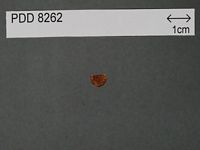|
 Hymenogaster aureus Hymenogaster aureus
BiostatusAbsent from region
Images (click to enlarge)
Caption: Hymenogaster aureus:
A habit and section (Beaton 17) x 1;
B spores x 1750; C basidia x 1000.< | 
Caption: Dried type specimen
Owner: Herb PDD |
Article: Beaton, G.W.; Pegler, D.N.; Young, T.W.K. (1985). Gasteroid Basidiomycota of Victoria State, Australia. 3. Cortinariales. Kew Bulletin 40(1): 167–204.
Description: Gasterocarp 1-2 cm diam., subglobose, with
basal attachment. Peridium very thin, chrome yellow (M.4Y/7.5/10.9) when fresh,
drying caramel brown, dry, pruinose, glabrescent. Gleba dull greyish brown to
ferruginous, loculate, with very small, compressed, irregular chambers, 3-5
per mm, with little or no radial arrangement. Tramal plates narrow, 25-40 µm
thick, hyaline, with a broad hymenophoral trama and poorly developed subhymenial
layers; hyphae 3-20 µm diam., thin-walled, lacking clamp-connexions. Sterile
base scarcely present.
Spores statismosporic, orthotropic, mostly
symmetric but many abnormal and asymmetric, 10.5-18 x 5-9.5(15 ± 1 x 6.3 ± 0.5)
µm, Q = 2-4; elongate-fusoid with a tapering apex, with a thickened, yellowish
brown wall, smooth. Basidia 20-25 x 7.5-10 µm, short clavate, bearing two short,
straight sterigmata. Cystidia absent, but numerous inflated, isodiametric brachycystidia
present between the basidia. Hymenophoral trama regular, hyaline, of parallel,
thin-walled hyphae, 3-16 µm diam. Subhymenial layer very narrow, interwoven.
Peridiopellis a thin epicutis, 10-30 µm thick, of repent, interwoven, thin-walled,
non-inflated hyphae, 2.5-7 µm diam., with a yellow encrusting pigment; surface
hyphae often erect or semi-erect but not forming a true trichodermium.
Notes: Hymenogaster aureus was described from Tasmania, and has been subsequently recorded from Queensland
by Cribb (1956: 126) but was not hitherto known from Victoria. The brightly
coloured gasterocarp occurs solitary, and is usually found only partially buried
in the soil. The spores appear quite smooth under the light microscope but scanning
micrographs reveal a very fine rugosity. Hymenogaster fusisporus (Massee
& Rodw.) G. H. Cunn., also from Tasmania, is very similar but has a dull
ochre brown peridium and hyaline, larger spores.
|